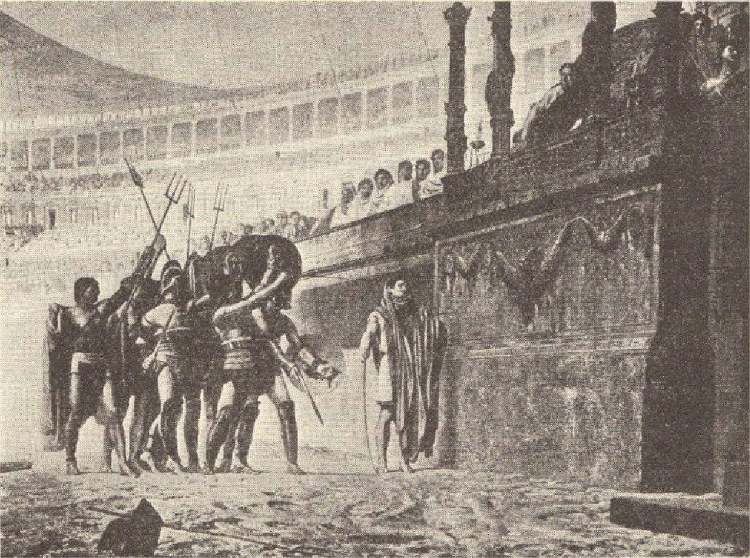| Ancient Roman Gladiators |
|---|
| www.studenthandouts.com ↣ World History ↣ Ancient Rome ↣ Ancient Rome Maps & Pictures |
 |
|
Gladiators before the emperor. In the group of combatants in the arena are several holding trident and net. They have overcome their opponents in full armor by entangling them in the net, then attacking them with the trident. Click here to enlarge.
Life for an ancient Roman gladiator was extremely challenging, often brutal, and carried a high risk of injury or death. Gladiators were typically slaves or prisoners of war who were forced to fight in the arena for the entertainment of Roman audiences. Enslavement or Voluntary Service: Gladiators were primarily slaves, prisoners of war, or condemned criminals. Some, however, chose to become gladiators voluntarily, often for the promise of financial rewards or a chance at fame. Training: Gladiators underwent rigorous training in specialized gladiator schools called ludi. Training included combat skills, physical conditioning, and mastering various weapons. It was intense, with strict discipline and harsh conditions. Types of Gladiators: There were various types of gladiators, each specialized in specific weapons and combat techniques. These included the murmillo, secutor, retiarius, and many others. Combat and Matches: Gladiators fought in the arena, often in pairs, with the outcome determined by the rules of the games. Some matches were relatively less deadly, with the aim of scoring points. Others were to the death. Audience and Fame: Gladiatorial games were highly popular, and the fighters could become local celebrities. Successful gladiators could earn the adoration of the crowd, gifts, and even their freedom in some cases. Risk of Injury and Death: The life expectancy of a gladiator was very low due to the constant risk of injury and death. While some gladiators survived many fights, others met a swift and brutal end. Treatment: Gladiators were typically owned by a lanista, a manager or trainer, who had a financial interest in keeping them alive and in fighting condition. However, the treatment of gladiators could vary, with some facing cruel and exploitative lanistae. Diet and Health: Gladiators were provided with a diet designed to enhance their physical strength and endurance. This diet often consisted of grains, legumes, and high-protein foods. Medical care was available to treat injuries, but it was rudimentary by modern standards. Social Status: While they were often looked down upon as slaves and entertainers, some gladiators gained a level of respect and admiration for their bravery and skill in the arena. Potential for Freedom: In some cases, gladiators could earn their freedom through acts of valor in the arena, a reward known as missio. However, it was not guaranteed, and the conditions for earning freedom could be challenging. End of Gladiatorial Combat: Gladiatorial games continued for several centuries, but as Roman society evolved, they eventually fell out of favor. Emperor Honorius abolished them in A.D. 399. The life of a gladiator was marked by physical hardship, the constant threat of violence, and the necessity to perform well to survive. Their experiences and the appeal of gladiatorial combat offer a fascinating and often unsettling glimpse into the culture of ancient Rome. |
 |  |  |  |  |  |
| Ancient Rome Books and Films | Ancient Rome Outlines and PowerPoints |
| Ancient Rome Maps and Pictures | Ancient Rome Study Games |
| Ancient Rome Miscellany | Ancient Rome Worksheets |
| www.studenthandouts.com ↣ World History ↣ Ancient Rome ↣ Ancient Rome Maps & Pictures |








